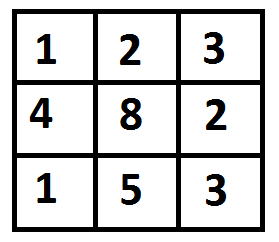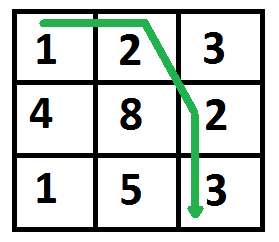原文地址:Dynamic Programming | Set 6 (Min Cost Path)
已知一个成本矩阵cost[][],位置(m, n)的权重是cost[][],写一个函数,这个函数返回从(0, 0)到(m, n)的最小带权路径。矩阵的每个格子表示的是通过这个格子的代价。到达(m, n)的路径总代价是这条路上所有代价和(包括出发点和终点)。你只可以从当前的格子向下,向右,或者对角线移动到下面的格子。例如给定(i, j),只可以移动到cells (i+1, j),(i, j+1) 和(i+1, j+1)。你可以假设所有的成本都是正整数。
例如,在下面的图中,到(2, 2)的最小带权路径是啥?

最小带权路径在下面的图中已经标记出来了,路径是(0, 0) –> (0, 1) –> (1, 2) –> (2, 2)。路径的成本是8 (1 + 2 + 2 + 3)。

1)最优的子结构
到达 (m, n) 的路径必须通过下面三个格子中的一个:(m-1, n-1)或者(m-1, n)或者(m, n-1)。所以到达(m, n)的最小成本快一些写成“到达三个格子的最小值加上cost[m][n]”。
minCost(m, n) = min (minCost(m-1, n-1), minCost(m-1, n), minCost(m, n-1)) + cost[m][n]
2)重复的子问题
下面是MCP(Minimum Cost Path)问题的一个比较简单的递归实现了。这个实现就是根据上面的递归结构来写的。
/* A Naive recursive implementation of MCP(Minimum Cost Path) problem */
#include<stdio.h>
#include<limits.h>
#define R 3
#define C 3
int min(int x, int y, int z);
/* Returns cost of minimum cost path from (0,0) to (m, n) in mat[R][C]*/
int minCost(int cost[R][C], int m, int n)
{
if (n < 0 || m < 0)
return INT_MAX;
else if (m == 0 && n == 0)
return cost[m][n];
else
return cost[m][n] + min( minCost(cost, m-1, n-1),
minCost(cost, m-1, n),
minCost(cost, m, n-1) );
}
/* A utility function that returns minimum of 3 integers */
int min(int x, int y, int z)
{
if (x < y)
return (x < z)? x : z;
else
return (y < z)? y : z;
}
/* Driver program to test above functions */
int main()
{
int cost[R][C] = { {1, 2, 3},
{4, 8, 2},
{1, 5, 3} };
printf(" %d ", minCost(cost, 2, 2));
return 0;
}应该注意的是,上面的方法重复计算了一些子问题,看下面这个递归树,有许多节点出现了多次,这个递归的时间复杂度是指数级的,运行起来超慢。
mC refers to minCost()
mC(2, 2)
/ | \
/ | \
mC(1, 1) mC(1, 2) mC(2, 1)
/ | \ / | \ / | \
/ | \ / | \ / | \
mC(0,0) mC(0,1) mC(1,0) mC(0,1) mC(0,2) mC(1,1) mC(1,0) mC(1,1) mC(2,0) 所以MCP问题有动态规划的两个属性(重复子问题与最优子结构),就像其他典型的DP问题一样,可以通过自底向上地构建一个临时数组tc[][]来避免重复计算相同的子问题。
/* Dynamic Programming implementation of MCP problem */
#include<stdio.h>
#include<limits.h>
#define R 3
#define C 3
int min(int x, int y, int z);
int minCost(int cost[R][C], int m, int n)
{
int i, j;
// Instead of following line, we can use int tc[m+1][n+1] or
// dynamically allocate memoery to save space. The following line is
// used to keep te program simple and make it working on all compilers.
int tc[R][C];
tc[0][0] = cost[0][0];
/* Initialize first column of total cost(tc) array */
for (i = 1; i <= m; i++)
tc[i][0] = tc[i-1][0] + cost[i][0];
/* Initialize first row of tc array */
for (j = 1; j <= n; j++)
tc[0][j] = tc[0][j-1] + cost[0][j];
/* Construct rest of the tc array */
for (i = 1; i <= m; i++)
for (j = 1; j <= n; j++)
tc[i][j] = min(tc[i-1][j-1], tc[i-1][j], tc[i][j-1]) + cost[i][j];
return tc[m][n];
}
/* A utility function that returns minimum of 3 integers */
int min(int x, int y, int z)
{
if (x < y)
return (x < z)? x : z;
else
return (y < z)? y : z;
}
/* Driver program to test above functions */
int main()
{
int cost[R][C] = { {1, 2, 3},
{4, 8, 2},
{1, 5, 3} };
printf(" %d ", minCost(cost, 2, 2));
return 0;
}输出:
8这个实现的时间复杂度是 O(mn),这比前面那个简单的递归实现好多了。

























 2956
2956

 被折叠的 条评论
为什么被折叠?
被折叠的 条评论
为什么被折叠?








